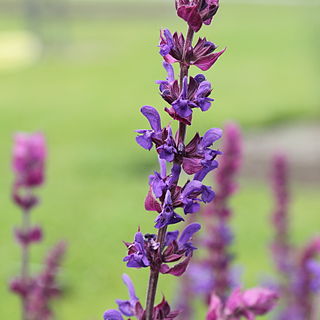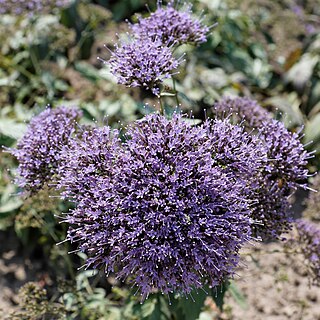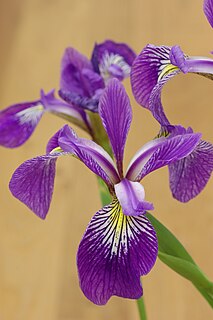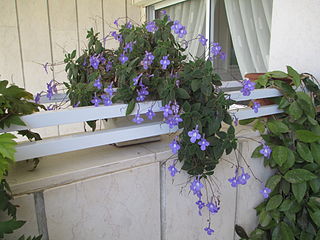
The Royal Horticultural Society (RHS), founded in 1804 as the Horticultural Society of London, is the UK's leading gardening charity.

Thujopsis is a genus of conifers in the cypress family (Cupressaceae), the sole member of which is Thujopsis dolabrata. It is endemic to Japan, where it is named asunaro (あすなろ). It is similar to the closely related genus Thuja (arborvitae), differing in the broader, thicker leaves and thick cones. It is also called hiba, false arborvitae, or hiba arborvitae.

Salvia splendens, the scarlet sage, is a tender herbaceous perennial plant native to Brazil, growing at 2,000 to 3,000 m elevation where it is warm year-round and with high humidity. The wild form, rarely seen in cultivation, reaches 1.3 m (4.3 ft) tall. Smaller cultivars are very popular as bedding plants, seen in shopping malls and public gardens all over the world.

Kerria japonica, commonly known as Japanese rose or Japanese kerria, is a deciduous shrub in the rose family Rosaceae, native to China, Japan and Korea. It is named after William Kerr, who introduced the cultivar 'Pleniflora'. It is the sole species in the genus Kerria.

Lavandula angustifolia, formerly L. officinalis, is a flowering plant in the family Lamiaceae, native to the Mediterranean. Its common names include lavender, true lavender or English lavender ; also garden lavender, common lavender, and narrow-leaved lavender.

Viola sororia, known commonly as the common blue violet, is a short-stemmed herbaceous perennial plant that is native to eastern North America. It is known by a number of common names, including common meadow violet, purple violet, woolly blue violet, hooded violet, and wood violet. Its cultivar 'Albiflora' has gained the Royal Horticultural Society's Award of Garden Merit.

Salvia pratensis, the meadow clary or meadow sage, is a species of flowering plant in the family Lamiaceae, native to Europe, western Asia and northern Africa. The Latin specific epithet pratensis means "of meadows", referring to its preferred habitat. It also grows in scrub edges and woodland borders.

Ramonda myconi, the Pyrenean-violet or rosette mullein, syn. R. pyrenaica, is a species of flowering plant in the family Gesneriaceae, which is a relictual endemite of shady, rocky places in the Pyrenees and north eastern Spain. It is a rosette-forming evergreen perennial growing to 10 cm (4 in) high by 20 cm (8 in) broad, with oval, crinkled leaves. Five-petalled purple flowers with prominent yellow anthers appear on leafless stems in spring.

Ipheion uniflorum is a species of flowering plant, related to the onions, so is placed in the allium subfamily (Allioideae) of the Amaryllidaceae. It is known by the common name springstar, or spring starflower. Along with all the species of the genus Ipheion, some sources place it in the genus Tristagma, but research published in 2010 suggested that this is not correct. It is native to Argentina and Uruguay, but is widely cultivated as an ornamental and reportedly naturalized in Great Britain, France, Australia, and New Zealand.

Salvia nemorosa, the woodland sage, Balkan clary, blue sage or wild sage, is a hardy herbaceous perennial plant native to a wide area of central Europe and Western Asia.

Salix acutifolia, also known as Siberian violet-willow, long-leaved violet willow or sharp-leaf willow, is a species of flowering plant in the family Salicaceae, native to Russia and eastern Asia. It is a spreading, deciduous shrub or tree, growing to 10 m (33 ft) tall by 12 m (39 ft) wide. The young shoots are deep purple with a white bloom. The leaves are narrow, up to 10 cm (4 in) long. The catkins are produced in early spring, before the leaves. Older bark has a fine, netted pattern.

Viola cornuta, known as horned pansy or horned violet, is a species of flowering plant in the violet family Violaceae, native to the Pyrenees and the Cordillera Cantábrica of northern Spain at an altitude of 1,000–2,300 metres (3,300–7,500 ft). It is a low-growing, clump-forming temperate evergreen perennial, reaching 50 cm (20 in) in height and spread. It has mid-green ovate leaves with rounded teeth, and masses of delicate pale violet flowers in early summer. The flower consists of five strap-shaped petals with a slender spur.

Iris lutescens, the Crimean iris, is a rhizomatous flowering plant in the genus Iris. It is native to North East Spain, Southern France and Italy. It is found on rocky or sandy hillsides or in woodlands.

Trachelium caeruleum, common name blue throatwort, is a species of flowering plant in the family Campanulaceae native to the Mediterranean, where its native range includes Algeria, Morocco, Portugal, Spain, and Sicily. It has also become naturalized in a few areas, including New Zealand, the Azores, and parts of mainland Europe.

Nepeta sibirica, the Siberian catmint, is a species of flowering plant in the mint family Lamiaceae, native to Siberia.

Thalictrum rochebruneanum, called the lavender mist meadow rue, is a species of flowering plant in the genus Thalictrum, native to the Korean Peninsula and Japan. A clumping perennial topped with a loose spray of small medium violet flowers with yellow stamens, and sometimes reaching 2 m (7 ft), it has gained the Royal Horticultural Society's Award of Garden Merit.

Iris × robusta, called the Windermere iris, is a hybrid species of flowering plant in the family Iridaceae. Its parents are Iris versicolor and Iris virginica, both of which are native to North America. Wild populations have been found in Michigan and Ontario, and it has been introduced into Great Britain. It is a rhizomatous perennial, characterised by its violet-blue flowers and purple-flushed foliage. It has a number of cultivars, including 'Gerald Darby', 'Mountain Brook', 'Purple Fan' and 'Nutfield Blue'. Its cultivar 'Dark Aura' has gained the Royal Horticultural Society's Award of Garden Merit.

Streptocarpus saxorum, called the false African violet, is a species of flowering plant in the genus Streptocarpus, subgenus Streptocarpella, native to Kenya and Tanzania. It is an evergreen perennial that often bears flowers nearly year-round. Its "compact" variety has gained the Royal Horticultural Society's Award of Garden Merit as a houseplant.

Cardamine quinquefolia, the five-leaved cuckoo flower or whorled coral-root, is a species of flowering plant in the family Brassicaceae, native to an area from south eastern Europe to northern Iran.


















